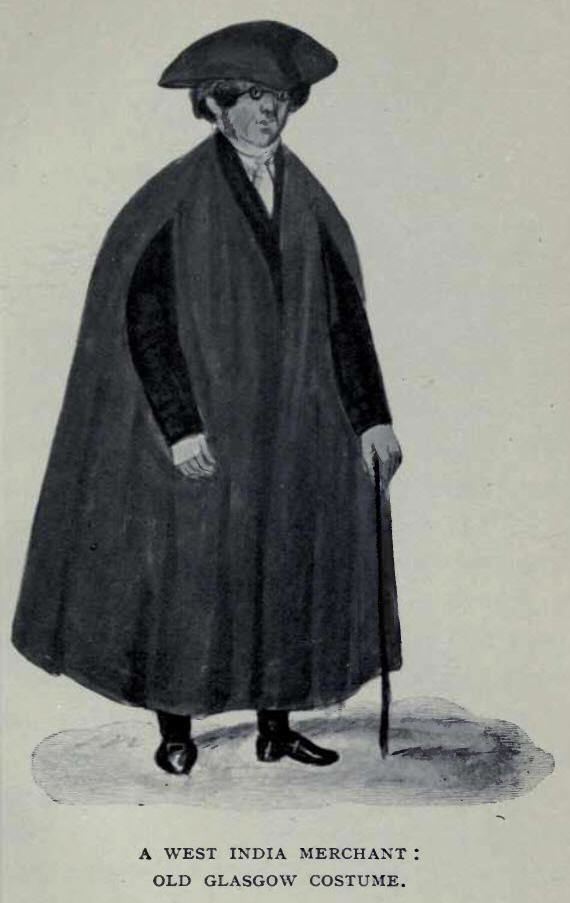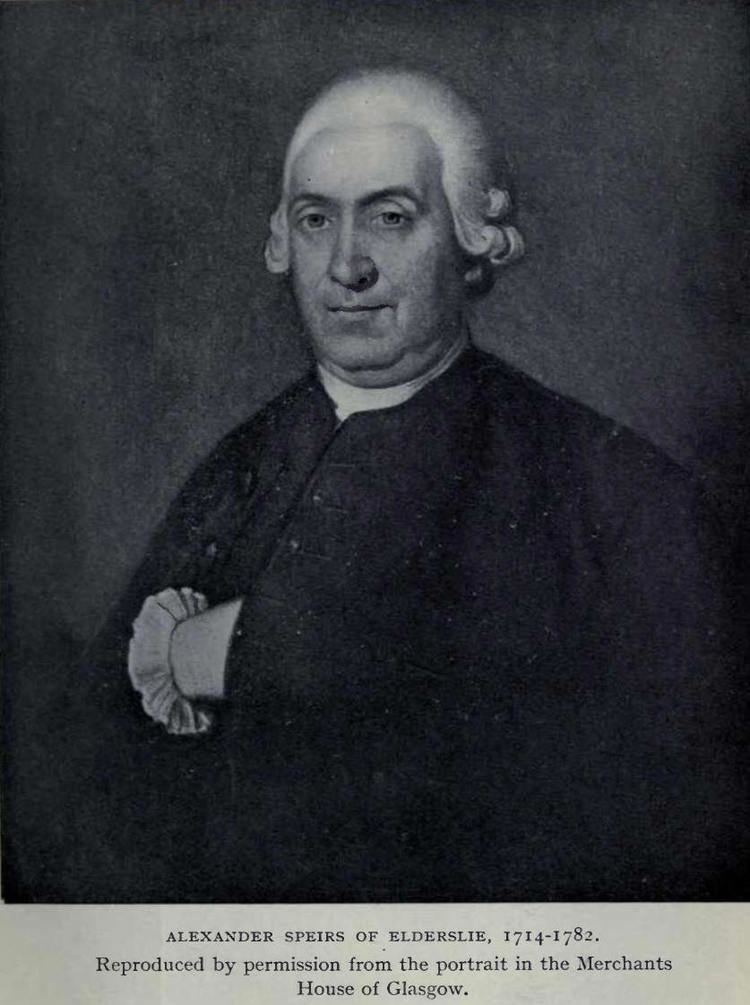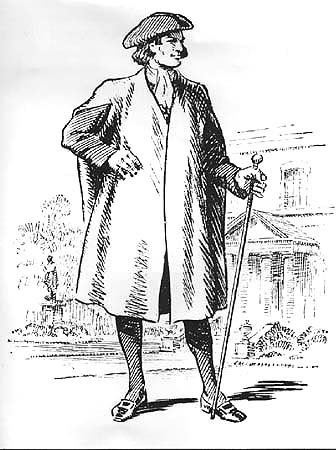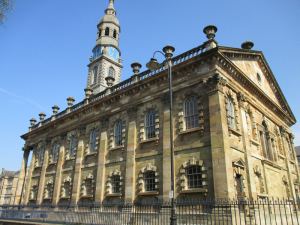 | ||
The Tobacco Lords (or “Virginia Dons”) were Glasgow merchants who in the 18th century made enormous fortunes by trading in tobacco from Great Britain's American Colonies. Many became so wealthy that they adopted the lifestyle of aristocrats, lavishing vast sums on great houses and splendid churches. Many suffered severe losses during and after the American Revolution.
Contents

History

In 1707, the Treaty of Union between Scotland and England gave Scottish merchants access to the English overseas territories, especially in North America. Glasgow's position on the River Clyde, where the trade winds first hit Europe, gave its merchants a two to three week advantage over other ports in Britain and Europe. This position was enhanced by the French monarchy granting it a monopoly for the importation of tobacco into French territories (1747) and later by the deepening of the Clyde in 1768. Glasgow ships were American-built specifically for the Atlantic crossing and were generally bigger than those of other ports. However, the main advantage of the Glasgow merchants seems to have been their extensive and personally supervised networks across Britain, Europe and the Americas.

The tobacco trade was part of the trade linking exports of consumer and manufactured goods from Britain and Europe to the North American and Caribbean colonies, who supplied tropical goods, including tobacco, sugar and rum in return. Later, a third leg on the transatlantic trade routes was added by English merchant carrying slaves from West Africa - thus establishing the so-called triangular trade.

From 1710 Glasgow became the focus of an economic boom which lasted nearly fifty years. This was the age of the Tobacco Lords, the nouveau riche of the mid-eighteenth century. Arguably the greatest of these merchants was John Glassford, who entered the tobacco trade in 1750 and soon made a success of his venture, with a fleet of vessels and many tobacco stores across New England. Celebrated in his lifetime, Glassford was the most extensive ship owner of his generation in Scotland, and one of the four merchants who laid the foundation of the commercial greatness of Glasgow through the tobacco trade. Tobias Smollett wrote of a meeting with Glassford in 1771:
Palaces and churches

Glasgow merchants made such fortunes that they adopted the style of aristocrats in their superior manner and in their lavish homes and churches. Their Calvinist background made sure, however, that display was always of rich but sober materials - black silk clothes, (though startlingly set off by scarlet cloaks), black three-cornered hats, silver- (or even gold)-tipped ebony canes, mahogany furniture, and classical architecture for their domestic and public use. Their mansions were laid out on the western boundaries of the 18th century city, where they gave their names to later streets in what is now called the Merchant City section of modern Glasgow. Other streets recall the triangular trade more directly - Virginia Street and Jamaica Street especially. Among the important Tobacco Lords whose mansions gave their names to streets were Andrew Buchanan, James Dunlop, Archibald Ingram, James Wilson, Alexander Oswald, Andrew Cochrane and John Glassford. The Virginia Mansion of Alexander Speirs gave Virginia Street its name, and Alexander gave his surname to Speirs Wharf in Port Dundas.

Some idea of the grandeur of the Tobacco Lords’ houses - which often dramatically punctuated the ends of the streets named after them - can be seen in the original core of Glasgow Gallery of Modern Art, which today occupies the (greatly expanded and embellished by later reconstruction as the Exchange) mansion built for William Cunninghame in 1780, at a cost of £10,000. A more modest Tobacco Merchants House (by James Craig, 1775) is being restored at 42 Miller Street.
St Andrew’s Parish Church in St Andrew’s Square, built 1739 - 1756 by Alan Dreghorn was the Tobacco Lord’s ostentatious parish church, in a prestigious area being laid out by such merchants as David Dale (who was not involved in the tobacco trade). In the same area was the grand house of Alexander Speirs.
St Andrew's in the Square still survives today and is considered one of the finest classical churches in Britain, Today it is Glasgow's Centre for Scottish Culture, promoting Scottish music, song and dance. The church is located in St Andrew's Square, near Glasgow Cross and Glasgow Green, on the edge of the City's East End. The church, inspired by St Martin-in-the-Fields in London, was built between 1739 and 1756 by Master Mason Mungo Naismith. It was the first presbyterian church built after the Reformation, and was commissioned by the city's Tobacco Lords as a demonstration of their wealth and power.
American Revolution
During the 1760s tensions grew between Britain and her American colonies, amongst which were economic stresses arising out of the perceived unfairness of the tobacco trade. The market in tobacco was dominated by the Glasgow merchants who manipulated prices (as the colonists claimed) and caused great distress among Maryland and Virginia planters, who by the time of the outbreak of war had accumulated debts of around £1,000,000, a huge sum at the time. These debts, as much as the taxation imposed by Westminster, were among the colonists' most bitter grievances. It was this extension of cheap credit that made the Glasgow men different. The English merchants simply sold American tobacco in Europe and took a commission. The Scots bought the crop at pre-arranged prices, and made large (and potentially risky) loans to their customers.
Prior to 1740, Glasgow merchants were responsible for the import of less than 10% of America's tobacco crop, but by the 1750s Glasgow handled more of the trade than the rest of Britain's ports combined. Heavily capitalised, and taking great personal risks, these men made immense fortunes from the "Clockwork Operation" of fast ships coupled with ruthless dealmaking and the manipulation of credit. Maryland and Virginia planters were offered easy credit by the Glaswegian merchants, enabling them to buy European consumer goods and other luxuries before harvest time gave them the ready cash to do so. But, when the time came to sell the crop, the indebted growers found themselves forced by the canny traders to accept low prices for their harvest simply in order to stave off bankruptcy. At his Mount Vernon plantation, future President of the United States George Washington saw his liabilities swell to nearly £2,000 by the late 1760s. Thomas Jefferson, on the verge of losing his own farm, accused British merchants of unfairly depressing tobacco prices and forcing Virginia farmers to take on unsustainable debt loads. In 1786, he remarked:
After the war, few of the enormous debts owed by the colonists would ever be repaid. Despite these setbacks, after the American War of Independence (1775 - 1783) the canny Glasgow merchants switched their attention to other profitable parts of the triangular trade, particularly cotton in the British West Indies.
Legacy
The impact of the Tobacco Lords on Glasgow's architectural heritage remains today. St Andrew's in the Square is today Glasgow's Centre for Scottish Culture, promoting Scottish music, song and dance. William Cunninghame's (greatly expanded and embellished) mansion now houses the Glasgow Gallery of Modern Art.
